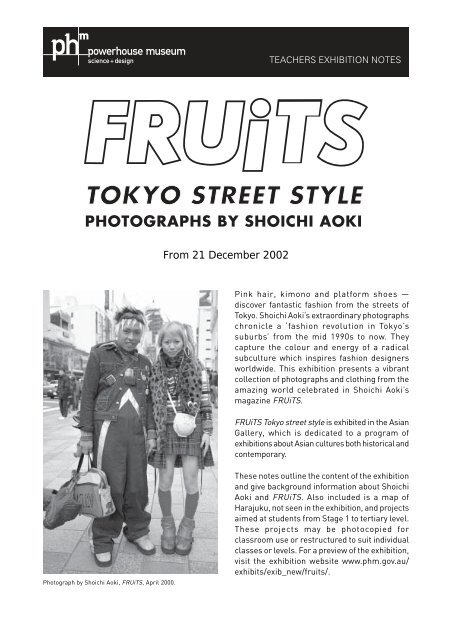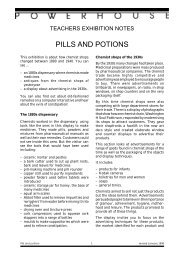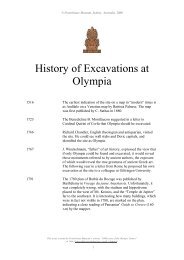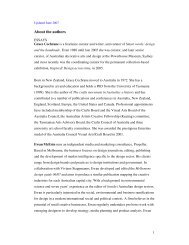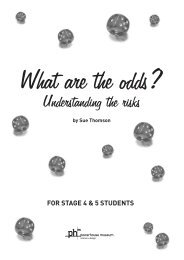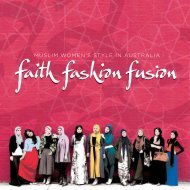fruits teachers notes.pmd - Powerhouse Museum
fruits teachers notes.pmd - Powerhouse Museum
fruits teachers notes.pmd - Powerhouse Museum
Create successful ePaper yourself
Turn your PDF publications into a flip-book with our unique Google optimized e-Paper software.
Photograph by Shoichi Aoki, FRUiTS, April 2000.<br />
From 21 December 2002<br />
Pink hair, kimono and platform shoes —<br />
discover fantastic fashion from the streets of<br />
Tokyo. Shoichi Aoki’s extraordinary photographs<br />
chronicle a ‘fashion revolution in Tokyo’s<br />
suburbs’ from the mid 1990s to now. They<br />
capture the colour and energy of a radical<br />
subculture which inspires fashion designers<br />
worldwide. This exhibition presents a vibrant<br />
collection of photographs and clothing from the<br />
amazing world celebrated in Shoichi Aoki’s<br />
magazine FRUiTS.<br />
FRUiTS Tokyo street style is exhibited in the Asian<br />
Gallery, which is dedicated to a program of<br />
exhibitions about Asian cultures both historical and<br />
contemporary.<br />
These <strong>notes</strong> outline the content of the exhibition<br />
and give background information about Shoichi<br />
Aoki and FRUiTS. Also included is a map of<br />
Harajuku, not seen in the exhibition, and projects<br />
aimed at students from Stage 1 to tertiary level.<br />
These projects may be photocopied for<br />
classroom use or restructured to suit individual<br />
classes or levels. For a preview of the exhibition,<br />
visit the exhibition website www.phm.gov.au/<br />
exhibits/exib_new/<strong>fruits</strong>/.
Curriculum links<br />
FRUiTS: Tokyo street style links directly to the<br />
following curriculum outcomes but is expected to<br />
be popular with students of all ages and interests.<br />
With clear and simple themes, there is great<br />
opportunity for expansion through hands-on<br />
activities, creative responses and, for older<br />
students, projects and research relating to fashion,<br />
society and culture, photography and design.<br />
>> Primary<br />
• Human Society and Its Environment<br />
• Creative Arts<br />
• LOTE — Japanese language studies<br />
>> Secondary<br />
• Society and Culture<br />
• Design and Technology<br />
• Textile Design<br />
• LOTE — Japanese language studies<br />
>> Tertiary<br />
• Fashion<br />
• Society and Culture<br />
• Design<br />
• Asian studies<br />
• Photography<br />
• Japanese Language and Culture<br />
Drawing by Maki, a FRUiTS reader, published in FRUiTS<br />
December 2000.<br />
About the exhibition<br />
In addition to over 70 photographs by Shoichi<br />
Aoki, the exhibition includes a variety of objects.<br />
Moving through the exhibition in a clockwise<br />
direction you will see:<br />
• examples of Shoichi Aoki’s FRUiTS magazine<br />
• clothing by Japanese labels Takuya Angel and<br />
Baby, the stars shine bright<br />
• examples of Shoichi Aoki’s STREET magazine<br />
• Tokyo street-style outfits worn by people<br />
featured in FRUiTS magazine<br />
• clothing and accessories by designers popular<br />
in Harajuku: Vivienne Westwood, Martin<br />
Margiela, 20471120 and Christopher Nemeth<br />
• Japanese designer label T-shirts<br />
• a limited-edition Astro Boy doll by Ohya.<br />
Two short videos in the exhibition explore<br />
different aspects of Tokyo street style. One<br />
includes a brief interview with Shoichi Aoki. A<br />
CD-ROM allows you to flick through the pages<br />
of several issues of FRUiTS magazine.<br />
Also on display outside the exhibition are a<br />
selection of tin toys made in Japan between 1950<br />
and 1969.<br />
TEACHERS NOTES 2
FRUiTS: TOKYO STREET STYLE<br />
Shoichi Aoki’s photographs document<br />
a revolutionary Japanese fashion<br />
movement that emerged on the<br />
streets of Harajuku, Tokyo, in the mid<br />
1990s. Unlike most fashion<br />
movements it was led not by<br />
designers but by young people,<br />
wearing an extreme mix of traditional<br />
Japanese dress, handmade and<br />
secondhand clothing, and designer<br />
fashion.<br />
In June 1997 Shoichi Aoki established<br />
a monthly magazine, which he still<br />
publishes, to ‘report on the cutting<br />
edge of youth fashion’ in Harajuku.<br />
He named the magazine FRUiTS to<br />
reflect the colour and freshness of the<br />
movement. The photographs in this<br />
exhibition were taken between 1997<br />
and 2002 and were originally<br />
published in FRUiTS.<br />
FRUiTS issue 43, December 2000.<br />
Here ‘fashion’ is more about the art of ‘putting<br />
things on’ than about the art of making clothes.<br />
Shoichi Aoki<br />
TEACHERS NOTES 3
SHOICHI AOKI<br />
Shoichi Aoki is photographer, editor<br />
and publisher of FRUiTS. Born in<br />
Tokyo in 1955, he worked as a<br />
computer programmer in the 1970s<br />
before leaving Japan for Europe,<br />
determined never to take another<br />
company job. After returning to<br />
Tokyo, Shoichi Aoki and Noriko<br />
Kojima started the magazine STREET.<br />
Launched in 1985, STREET introduced<br />
European avant-garde street fashion<br />
to Japan and is still in publication.<br />
Shoichi Aoki believes that fashion is<br />
an important form of communication;<br />
he is interested in the ways people<br />
express themselves through dress,<br />
rather than the individual garments<br />
they wear. For most of the<br />
photographs in FRUiTS he has<br />
recorded the subject’s name and age,<br />
as well as a short description of their<br />
outfit, current obsessions and ‘point<br />
of fashion’ or motivations.<br />
Shoichi Aoki, 2002.<br />
Fashion tends to be seen as a lower form of art.<br />
But in fact, in the beginning when people started<br />
to adorn the body or paint on the body wasn’t<br />
fashion, more than its functionality, born to<br />
express the difference between the self and<br />
others as a form of identification?<br />
If we think that consciousness of the difference<br />
between ourself and others marks the beginning<br />
of humanity, then fashion is probably the first<br />
art form to which humans gave birth. This made<br />
me interested in fashion. Here ‘fashion’ is more<br />
about the art of ‘putting things on’ than about<br />
the art of making clothes.<br />
Shoichi Aoki<br />
TEACHERS NOTES 4
FRUiTS STYLES<br />
The diverse styles in FRUiTS are<br />
continually evolving and often<br />
unique. Some popular looks are wamono,<br />
a mix of Japanese and western<br />
styles; cyber, a ‘futuristic’ combination<br />
of bright colours and plastics; decora,<br />
in which toys and plastic jewellery are<br />
worn so that their clinking sound<br />
adds a ‘musical’ dimension to the<br />
outfit; and punk.<br />
Clothing based on cartoon characters<br />
such as Sailor Moon is also<br />
fashionable. Called cosplay (costume<br />
play) the style refers not only to<br />
dressing as a specific character but<br />
also as a generic ‘type’, for example<br />
a waitress or nurse. Overtly cute or<br />
kawaii outfits, most often in shades of<br />
pink, have a strong presence in<br />
Harajuku as do frilly doll-like ‘Lolita’<br />
looks. ‘Elegant Gothic Lolita’, a<br />
blacker version of Lolita style, is<br />
inspired by the elaborate outfits of<br />
Japanese ‘visual rock’ bands. Rap,<br />
hip hop and skate styles are also<br />
popular.<br />
Top to bottom: Lolita, cyber and decora styles. Photographs by<br />
Shoichi Aoki from FRUiTS May 1998, June 1999, September 2001.<br />
TEACHERS NOTES 5
FASHION IN JAPAN<br />
Elaborate clothing, including the<br />
exaggerated beauty of geisha dress<br />
and the complexity of samurai<br />
armour, has a long history in Japan.<br />
Pattern, colour and layers of<br />
garments were used to indicate<br />
wealth and social status. Western<br />
clothing was introduced in the Meiji<br />
period (1868–1912) and has been<br />
prevalent since World War II.<br />
According to Shoichi Aoki “the<br />
average Japanese person’s<br />
perception of their own traditional<br />
kimono culture was of an avantgarde<br />
and unconventional medium —<br />
adventurous, bright and colourful …<br />
Western modes of dressing seemed,<br />
by contrast, drab and limiting.”*<br />
In the 1970s and 80s designers Issey<br />
Miyake, Rei Kawakubo (Comme des<br />
Garçons) and Yohji Yamamoto<br />
created an international fashion<br />
sensation with innovative garments<br />
that drew on Japanese and western<br />
traditions. When Harajuku street style<br />
emerged in the mid 1990s one of its<br />
extraordinary features was the<br />
combination of traditional dress —<br />
kimono, obi sashes and geta sandals<br />
— with designer fashion and<br />
alternative streetwear such as punk.<br />
* Shoichi Aoki, FRUiTS, Phaidon Press, 2001<br />
Ryuko was photographed by Shoichi Aoki for FRUiTS, April<br />
1998, wearing a handmade skirt, shoes by Yohji Yamamoto and<br />
a bag by Issey Miyake.<br />
Because western clothing has a short history in<br />
Japan, there is a strong tendency for people to<br />
dress in the same style as each other. Essentially<br />
this tendency has not changed. In Japan, having<br />
a different style is a kind of risk. Even the<br />
designer brand boom of the 1980s did not<br />
change that. People only took suggestions from<br />
the designers — in the same manner as<br />
everyone else.<br />
Therefore the fashion movement that came<br />
about in Harajuku was a revolution. This kind of<br />
fashion was not ‘suggested’ by designers, but<br />
rather, the fashion of the young inspired the<br />
designers. On the streets of Harajuku, there was<br />
no risk in having a different style. In fact it was<br />
considered worthwhile.<br />
Shoichi Aoki<br />
TEACHERS NOTES 6
HARAJUKU<br />
Harajuku is situated between two of<br />
Tokyo’s major commercial centres,<br />
Shibuya and Shinjuku. The opening<br />
of the Meiji Jingu Shrine in the 1920s<br />
first brought visitors to Harajuku, but<br />
it was the 1964 Tokyo Olympics that<br />
transformed the quiet residential<br />
area. The excitement surrounding the<br />
games attracted young people to<br />
Harajuku, and it is still one of Tokyo’s<br />
most vibrant and fashionable areas.<br />
Harajuku was the birthplace of<br />
several crazes including takenokozoku<br />
— a 1970s fad where brightly<br />
dressed people danced to recorded<br />
music on the side of the road — and<br />
similarly rock ’n’ roller-zoku and<br />
band-zoku. The area’s Elvis Presley<br />
impersonators are infamous. Between<br />
1977 and 1998 a section of road in<br />
Harajuku was closed to traffic on<br />
Sundays, creating Hokoten or<br />
‘pedestrian paradise’.<br />
Dancing Elvises in Harajuku.<br />
Hokoten<br />
One of the primary reasons this kind of youth<br />
culture came out of Harajuku was Hokoten<br />
(‘pedestrian paradise’). Hokoten happened every<br />
Sunday when one kilometre of Harajuku’s main<br />
road was blocked to cars. This section of road<br />
became a public square. The idea of Hokoten is<br />
precious because the concept of a public square<br />
did not exist in Japan. Many young people<br />
dressed in their finery and gathered there. This<br />
kind of fashion spread to other days in Harajuku<br />
and influenced fashion nationwide.<br />
Hokoten was terminated in 1998 and Harajuku<br />
gradually returned to its original state. The<br />
momentary avant-garde and creative fashion<br />
has mostly disappeared. The photos introduced<br />
here are the precious documentation of the<br />
fashion movement. Still, publication of FRUiTS<br />
continues … I am looking forward to the same<br />
kind of explosion happening again.<br />
Shoichi Aoki<br />
TEACHERS NOTES 7
��<br />
�����<br />
���<br />
����<br />
����<br />
�<br />
�������<br />
������<br />
�����<br />
��<br />
������� ����<br />
���<br />
�����<br />
���<br />
�������<br />
����<br />
����<br />
����<br />
�������<br />
����<br />
�<br />
��������<br />
����������<br />
�����������������<br />
�����<br />
���������<br />
������������<br />
�<br />
������<br />
������<br />
������������<br />
��������<br />
�����������������<br />
������������<br />
����������������<br />
���������� �<br />
�<br />
�������<br />
�����<br />
���<br />
����<br />
��������������<br />
��������������<br />
������������������<br />
����������������<br />
��<br />
��<br />
��<br />
�<br />
��<br />
�<br />
��<br />
��<br />
�������<br />
��<br />
�<br />
�<br />
�������������<br />
���������<br />
����������<br />
���������<br />
����<br />
���<br />
������<br />
��������<br />
���������<br />
����<br />
������������<br />
������<br />
���������<br />
������������<br />
����<br />
�������<br />
������<br />
������������������<br />
�����������������<br />
����<br />
����������� �<br />
�������� ��<br />
��<br />
�������������<br />
������<br />
�������<br />
����������<br />
�ö���<br />
��������������<br />
����<br />
������<br />
����<br />
������<br />
���������������<br />
���<br />
�������������<br />
�����<br />
�����<br />
������<br />
�����<br />
������������������<br />
����<br />
�����������<br />
��������<br />
��������<br />
���<br />
����<br />
������<br />
����<br />
������<br />
�����<br />
��<br />
���������<br />
���<br />
���<br />
��������<br />
����<br />
���������<br />
���������<br />
��<br />
��<br />
��<br />
��<br />
��<br />
��<br />
��<br />
��<br />
��<br />
��<br />
��<br />
��<br />
��<br />
��<br />
��<br />
��<br />
����<br />
����<br />
���<br />
����������<br />
���<br />
�����������<br />
Harajuku map from FRUiTS, May 2000.
1. FRUiTty fashion paper dolls<br />
page 10–11<br />
Recommended: early stage 1 — stage 3<br />
Type: individual activity<br />
Instructions<br />
1. Photocopy pages 10–11 for each student.<br />
2. Students draw their own face on the paper doll.<br />
3. Students decorate and/or colour-in clothing,<br />
hair and shoes.<br />
4. Students cut-out paper doll and all accessories.<br />
Notes<br />
As younger students will require assistance with<br />
cutting, a small selection of clothing and<br />
accessories is advised.<br />
160 gsm paper is recommended as it is durable<br />
but can still be used in a regular photocopier.<br />
However regular copy paper may still be used.<br />
2. Homemade Harajuku style<br />
Recommended: stages 1–6<br />
Type: class or group project<br />
Instructions<br />
Part 1<br />
1. Class discussion: what is fashion?<br />
2. Class discussion: what does Shoichi Aoki<br />
think fashion is?<br />
‘“Fashion” is more about the art of “putting<br />
things on” than about the art of making<br />
clothes’. Shoichi Aoki<br />
For example, you may have a simple T-shirt,<br />
pair of pants, jacket and shoes. If you add a<br />
wild hairstyle, leg-warmers and accessories,<br />
you suddenly have a Tokyo ‘street style’ look.<br />
Part 2<br />
3. Gather and prepare scraps of fabric, ribbon etc.<br />
4. Students bring a selection of own clothing<br />
from home.<br />
Student projects and activities<br />
5. Students dress up using own clothing<br />
and extra fabric etc to create a ‘street style’<br />
look.<br />
Part 3 (optional)<br />
6. Photograph each student and hang photos on<br />
wall to create the class’s own ‘street style’<br />
exhibition.<br />
7. Students write own labels with the following<br />
information: name, age and style (or<br />
influences).<br />
Notes<br />
For older students the project can be extended<br />
in the following ways:<br />
Part 1: in groups, students research a style of<br />
fashion and how that ‘look’ evolved.<br />
Part 2: students collect recycled materials in<br />
order to create their own ‘street style’ fashion.<br />
Part 3: students photograph each other either<br />
in the school setting or local street setting to<br />
produce their own exhibition.<br />
3. Fresh FRUiTS competition<br />
Open to: design students studying fashion,<br />
design or photography at secondary school or<br />
tertiary level<br />
Type: individual or group project<br />
Final entry date: Friday 20 June 2003<br />
Students create their own ‘street style’ look and<br />
photograph themselves in a street setting.<br />
Finalists will be displayed at the <strong>Powerhouse</strong><br />
<strong>Museum</strong>.<br />
For full details contact:<br />
Rita Bila<br />
Ph: (02) 9217 0380<br />
Email: ritab@phm.gov.au<br />
TEACHERS NOTES 9
FRUiTty fashion paper dolls<br />
TEACHERS NOTES 10
TEACHERS NOTES 11
Books<br />
Aoki, Shoichi, FRUiTS, Phaidon, New York, 2001<br />
Baudot, Francois, Yohji Yamamoto, Thames and<br />
Hudson, London,1997<br />
Benaim, Laurence, Issey Miyake, Thames and<br />
Hudson, London,1997<br />
Buckley, Sandra (ed), Encyclopedia of<br />
contemporary Japanese culture, Routledge,<br />
London and New York<br />
Bullis, Douglas, Fashion Asia, Thames and<br />
Hudson, New York, 2000<br />
Grand, France, Comme des Garçons, Thames<br />
and Hudson, London, 1998<br />
Lunn, Stephen, ‘Made in Japan’, Australian<br />
Magazine, 16–17 March 2002<br />
Takamura, Zenshu, Roots of street style, Books<br />
Nippan, Tokyo, 1996<br />
Teunissen, José, Made in Japan, Centraal<br />
<strong>Museum</strong>, Utrecht, 2001<br />
Wilcox, Claire, Radical fashion, Harry N Abrams,<br />
London, 2001<br />
>> Internet<br />
About the exhibition<br />
• www.phm.gov.au/exhibits/exib_new/<strong>fruits</strong>/<br />
For more information on the exhibition FRUiTS:<br />
Toyko street style, photographs by Shoichi Aoki,<br />
visit the <strong>Powerhouse</strong> <strong>Museum</strong>’s website<br />
http://www.phm.gov.au<br />
Further reading and resources<br />
About FRUiTS<br />
• http://www.<strong>fruits</strong>-mg.com/pc/english/e/<br />
index.html<br />
• http://www.slucky.net/lolita/giantrobot.html<br />
(interview with Aoki)<br />
About Harajuku style<br />
• http://www.rebeccamead.com/2002/<br />
2002_03_18_art_shopping.htm<br />
• http://www.insite-tokyo.com/column/<br />
douglas/index8.html<br />
• www.morbidoutlook.com/fashion/articles/<br />
2002_07_gothlolita.html<br />
About the designers featured in the exhibition<br />
• http://www.historyofcostume.com/<br />
historyofashion/margiela.html<br />
• http://www.babyssb.co.jp<br />
• www.virtualrunway.com<br />
• www.isseymiyake.com<br />
• www.yohjiyamamoto.co.jp<br />
• http://www.superlovers.co.jp/english/<br />
index.html<br />
• http://ip.tosp.co.jp/i.asp?i=ihpTA<br />
(Takuya Angel, in Japanese)<br />
• http://ja.tezuka.co.jp/ohya/<br />
(Ohya, in Japanese)<br />
Please note<br />
These websites were available and suitable at the time of<br />
publication. We advise that <strong>teachers</strong> should check sites before<br />
recommending them to students.<br />
For more information about education support<br />
or your booking, contact Education and Visitor<br />
Services at the <strong>Powerhouse</strong> <strong>Museum</strong>:<br />
Telephone — (02) 9217 0222<br />
Fax — (02) 9217 0441<br />
Email — edserv@phm.gov.au<br />
© 2003 Trustees of the <strong>Museum</strong> of Applied Arts and Sciences. This publication is copyright. Apart from fair dealing for the purposes of research, study, criticism or review, or as<br />
otherwise permitted under the Copyright Act, no part may be reproduced by any process without written permission.<br />
TEACHERS NOTES 12


